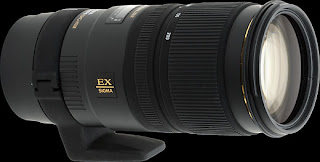The 70-200mm F2.8 OS sports a brand-new optical optical formula which incorporates a new weapon in the lens maker's armory, the latest type of glass which Sigma calls 'FLD' for 'F' Low Dispersion. This slightly opaque nomenclature indicates that it has similar optical properties to Fluorite, an expensive and difficult-to-work material that Canon has employed in the course of establishing its reputation as a maker of excellent telephotos. The 70-200mm F2.8 OS HSM uses two FLD elements within its 22 element / 17 group construction, alongside three elements made from the more conventional Super-Low Dispersion (SLD) glass. Sigma promises that this should give excellent correction for residual chromatic aberration.
The lens's impressive specification is rounded off with a 9-blade circular aperture for the attractive rendition of out-of-focus regions of the image, plus an adapter that extends the length of the lens hood to provide more effective shading for users of APS-C format DSLRs. The minimum focus distance is 1.4m, with a maximum magnification of 0.13x, which is a step back from the 1m minimum focus and 0.28x magnification of the most recent 70-200mm F2.8 EX DG Macro HSM II. All this is topped-off by a price which, while substantially higher than the older lens, is still substantially lower than its Nikon and Canon equivalents. On paper at least, this all adds up to a mouthwatering package; so let's see how well the lens lives up to its promise.
Sigma 70-200mm F2.8 design history
•70-200mm F2.8 EX APO - Original version, minimum focus distance 1.8m (1999)
•70-200mm F2.8 EX DG - Addition of 'digitally optimized' lens coatings to reduce flare (2005)
•70-200mm F2.8 EX DG Macro (HSM) - Minimum focus distance reduced to 1m (2006)
•70-200mm F2.8 EX DG Macro HSM II - Improved optical performance (2007)
•70-200mm F2.8 EX DG OS HSM - All-new design with built-in Optical Stabilization (2010)
Headline features
•70-200mm focal length range; fast F2.8 constant maximum aperture
•Optical image stabilization – 4 stops claimed
•Ring-type HSM focusing with full-time manual override
•Available in Canon, Nikon, Pentax, Sigma and Sony mounts
Angle of view
The pictures below illustrate the focal length range from wide to telephoto, on 35mm full-frame and APS-C camera bodies:
70mm (full frame)
70mm (APS-C; 112mm equivalent)
200mm (full frame)
200mm (APS-C; 320mm equivalent)





omg, zoom tele lens from sigma, sharp and good
ReplyDeleteas a first time visitor to your blog I am very impressed.
thank you :)